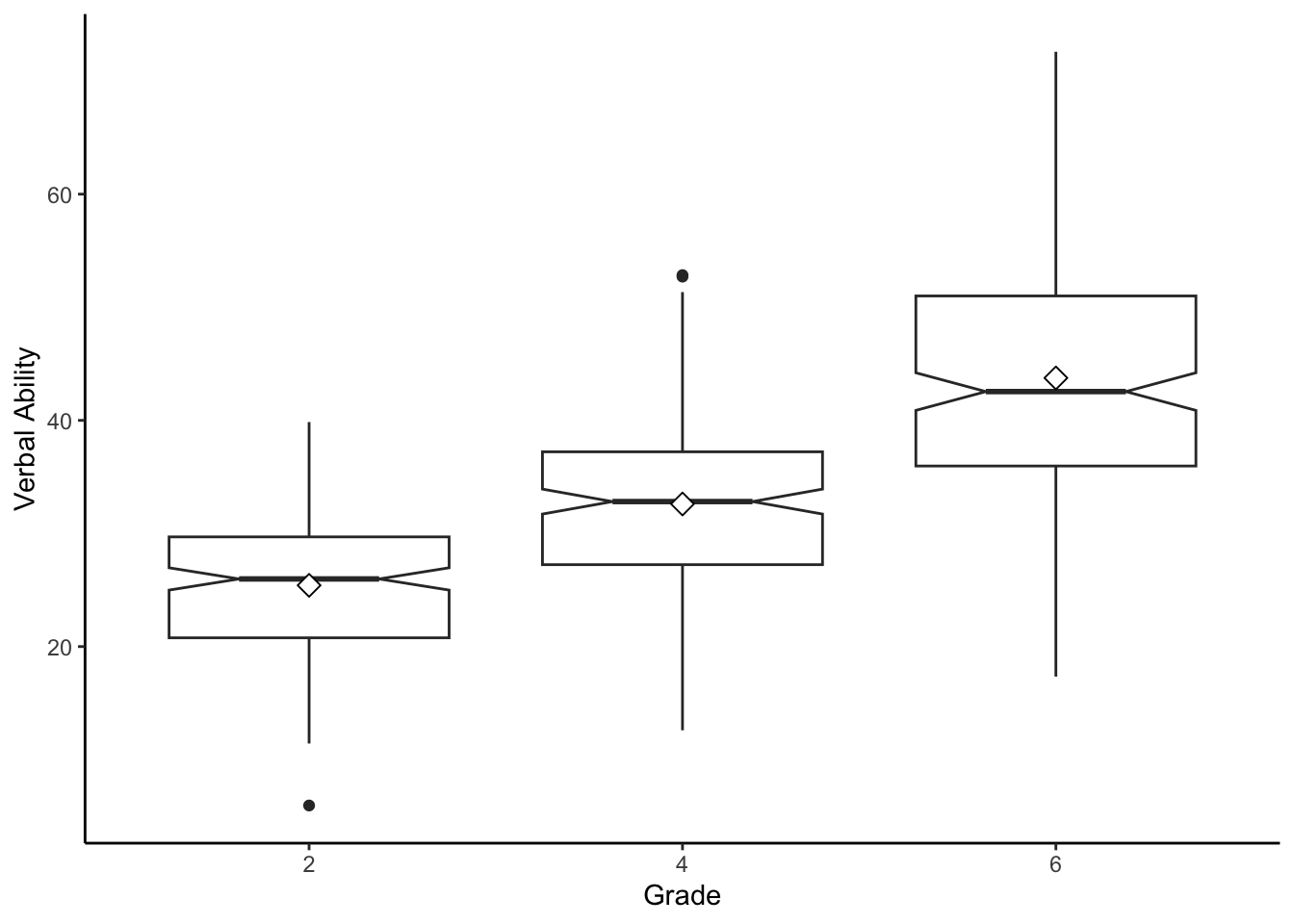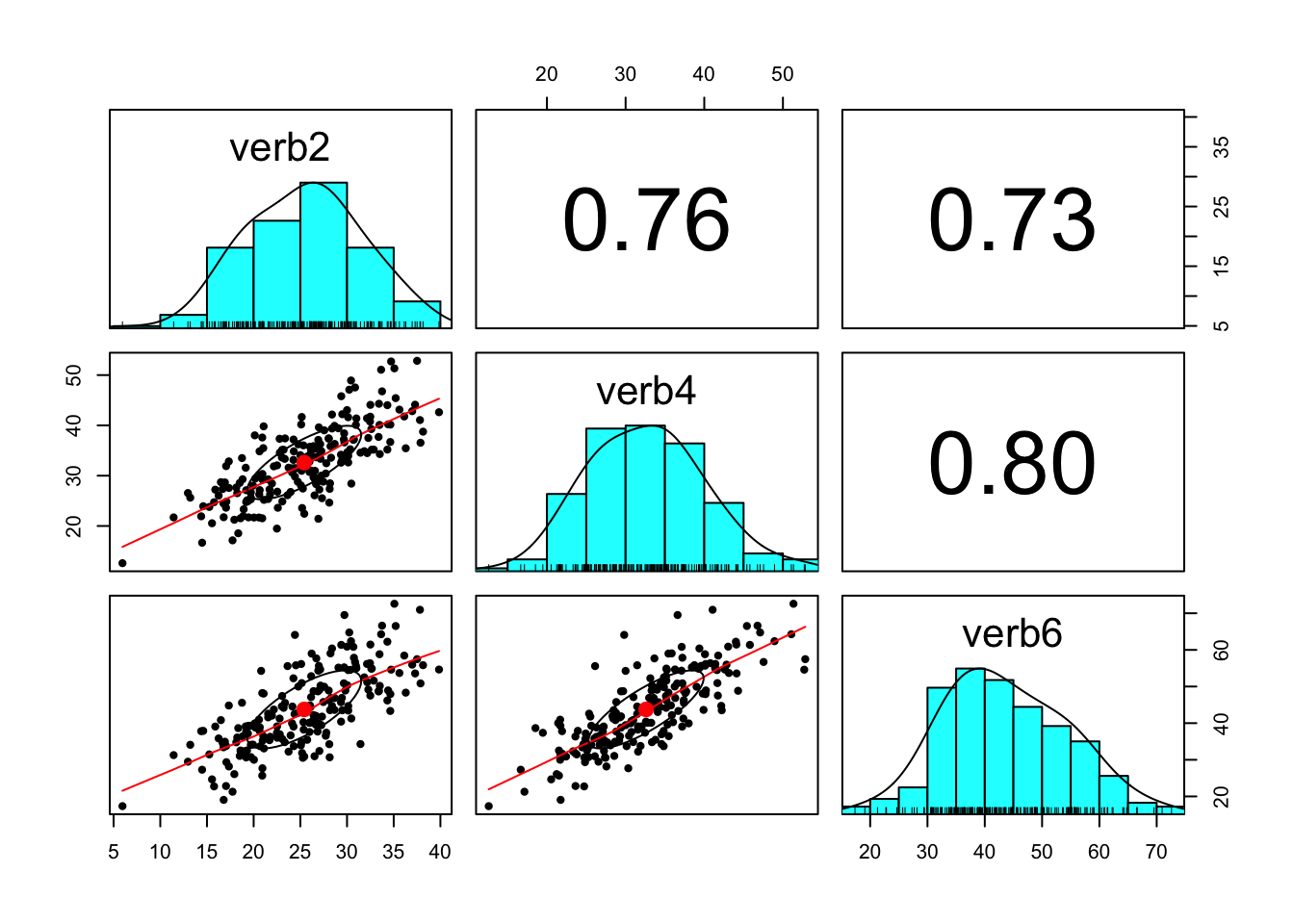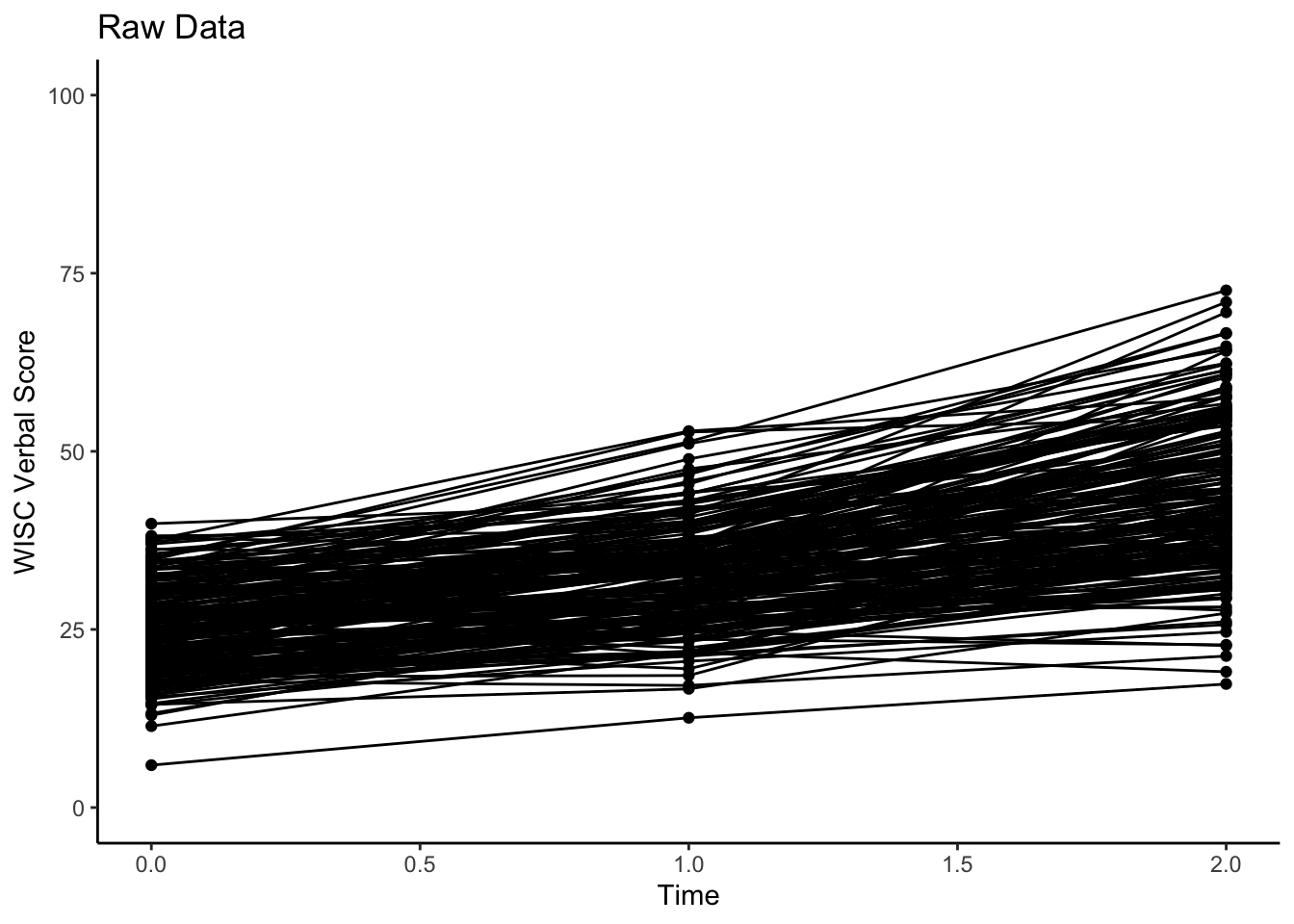12.2 Example Data
Loading some new libraries used in this chapter.
library(psych) # for descriptives etc
library(ggplot2) # for plotting
library(nlme) # for mixed effects models
library(lme4) # for mixed effects models
library(lmerTest) # to get significance tests from lmer12.2.1 Data Preparation and Description
For our examples, we use 3-occasion WISC data that are equally spaced.
Load the repeated measures data
filepath <- "https://quantdev.ssri.psu.edu/sites/qdev/files/wisc3raw.csv"
wisc3raw <- read.csv(file=url(filepath),header=TRUE)Next, let’s Subset the variables of interest. For this chapter we will include:
- 3-occasion equally spaced repeated measures (
verb2,verb4,verb6) - A person-level grouping variable (
grade) - An ID variable (
id)
After subsetting let’s take a look at some basic descriptives.
varnames <- c("id","verb2","verb4","verb6","grad")
wiscsub <- wisc3raw[ ,varnames]
describe(wiscsub)## vars n mean sd median trimmed mad min max range skew
## id 1 204 102.50 59.03 102.50 102.50 75.61 1.00 204.00 203.00 0.00
## verb2 2 204 25.42 6.11 25.98 25.40 6.57 5.95 39.85 33.90 -0.06
## verb4 3 204 32.61 7.32 32.82 32.42 7.18 12.60 52.84 40.24 0.23
## verb6 4 204 43.75 10.67 42.55 43.46 11.30 17.35 72.59 55.24 0.24
## grad 5 204 0.23 0.42 0.00 0.16 0.00 0.00 1.00 1.00 1.30
## kurtosis se
## id -1.22 4.13
## verb2 -0.34 0.43
## verb4 -0.08 0.51
## verb6 -0.36 0.75
## grad -0.30 0.03Multilevel modeling analyses typically require a long data set. So, we also reshape from wide to long in order to have a long data set.
verblong <- reshape(
data = wiscsub,
varying = c("verb2","verb4","verb6"),
timevar = "grade",
idvar = "id",
direction = "long",
sep = ""
)
verblong <- verblong[order(verblong$id,verblong$grade), c("id","grade","verb","grad")]
head(verblong,12)## id grade verb grad
## 1.2 1 2 26.98 0
## 1.4 1 4 39.61 0
## 1.6 1 6 55.64 0
## 2.2 2 2 14.38 0
## 2.4 2 4 21.92 0
## 2.6 2 6 37.81 0
## 3.2 3 2 33.51 1
## 3.4 3 4 34.30 1
## 3.6 3 6 50.18 1
## 4.2 4 2 28.39 1
## 4.4 4 4 42.16 1
## 4.6 4 6 44.72 112.2.2 Sample Moments
For clarity, let’s consider the basic information representation of the 3-occasion repeated measures data. In particular, data (even non-repeated measures data) are summarized (at the sample-level) as (1) a vector of means and (2) a variance-covariance matrix.
#mean vector (from wide data)
meanvector <- sapply(wiscsub[ ,c("verb2","verb4","verb6")], mean, na.rm=TRUE)
round(meanvector,2)## verb2 verb4 verb6
## 25.42 32.61 43.75#variance-covariance matrix (from wide data)
varcovmatrix <- cov(wiscsub[ ,c("verb2","verb4","verb6")], use="pairwise.complete.obs")
round(varcovmatrix,2)## verb2 verb4 verb6
## verb2 37.29 33.82 47.40
## verb4 33.82 53.58 62.25
## verb6 47.40 62.25 113.74Making visual counterparts can also be extremely useful - especially for facilitating higher-level conversations in a research group. Basic sample-level descriptions in visual form. Note that the time variable has been converted to a factor = categorical
ggplot(data=verblong, aes(x=factor(grade), y=verb)) +
geom_boxplot(notch = TRUE) +
stat_summary(fun.y="mean", geom="point", shape=23, size=3, fill="white") +
labs(x = "Grade", y = "Verbal Ability") +
theme_classic()## Warning: The `fun.y` argument of `stat_summary()` is deprecated as of ggplot2 3.3.0.
## ℹ Please use the `fun` argument instead.
## This warning is displayed once every 8 hours.
## Call `lifecycle::last_lifecycle_warnings()` to see where this warning was
## generated.

Reminder, we should always be careful about the scaling of the x- and y-axes in these plots.
One additional recoding for convenience is to center and scale our time variable. This gives us a specific \(0\) point and an intuitive \(0, 1, 2\) scale that is useful for our didactic purposes.
## [1] 2 4 6## [1] 0 1 2## id grade verb grad time0
## 1.2 1 2 26.98 0 0
## 1.4 1 4 39.61 0 1
## 1.6 1 6 55.64 0 2
## 2.2 2 2 14.38 0 0
## 2.4 2 4 21.92 0 1
## 2.6 2 6 37.81 0 2
## 3.2 3 2 33.51 1 0
## 3.4 3 4 34.30 1 1
## 3.6 3 6 50.18 1 2
## 4.2 4 2 28.39 1 0
## 4.4 4 4 42.16 1 1
## 4.6 4 6 44.72 1 2Plotting the raw data along this new time variable.
#plotting intraindividual change RAW DATA
ggplot(data = verblong, aes(x = time0, y = verb, group = id)) +
ggtitle("Raw Data") +
geom_point() +
geom_line() +
xlab("Time") +
ylab("WISC Verbal Score") +
ylim(0,100) + xlim(0,2) +
theme_classic()
Note that the time variable in this plot has NOT been converted to a factor. It is a continuous variable.